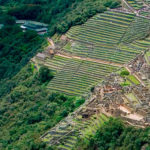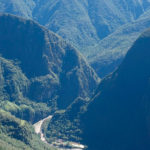Queswachaca better known as “the last Inca bridge” made of vegetable fiber (ichu) located on the Apurímac river in the district of Quehue, province of Canas in the department of Cuzco in southern Peru. The existence of this bridge dates back to Inca times and its maintenance and renovation is carried out through a rite carried out by the communities of Winch’iri, Chaupibanda, Ccollana Quehue and Perccaro.
It measures 28 meters long and 1.20 meters wide, its structure is made of braided “ichu”.
Its name Queswachaca in Quechua means rope bridge, used as a means of connection between the districts of Canas and Chumbivilcas. Without a doubt, this infrastructure dazzles you from the amount in which you appreciate it and the truth of it is that the custom of building it with the same technique used by the Incas is still maintained.
Upon reaching the Queswachaca bridge, you can see a unique area of abundant vegetation and the Apurímac river that has a turquoise color where the marine fauna does not go unnoticed since you can see some river trout that enjoy their habitat in a place that preserves Its purity and does not affect the environment. This context is ideal to take back not only the memory of the experience lived but also a beautiful photo that I know will undoubtedly give you many likes on your Instagram profile!
Well, do not forget to live the experience of crossing the last Inca bridge and ask for a wish from the heart because they say that for each bridge built by the hand of the Inca, he grants you a wish, but ask me and I am writing to you so that you can live this and many other experiences. More than Cusco and its different provinces will work for you.
Each one with a different story, for example, going over that bridge is a bit scary because it is hanging and it tends to move a bit when you walk on it, but it is worth living the adventure and experimenting or just believing for a moment and trying to go back to history and imagine how the Incas passed by and not walking like us but running…
Well, we are not chasquis, but we cross the bridge and you take a few photos of us on the bridge and with the kind gentleman from the Ministry of Culture who takes care of the bridge so that it continues to be preserved until you arrive and have the opportunity that I had to be a snap for a day..
After the wonderful experience of living history, we got back on the bus that took us from the plain to a living historical place to a natural place. The desire to see made my body tremble since I was dazzled by the tremendous handmade bridge.
What I had seen now I was dying of curiosity with what he would surprise us with, Our Guide who until now was very kind to us, who resolved each of the doubts we had and the driver was the most smiling person I had ever met and so kind that I know I will never forget them because they allowed me to live a tremendous experience and they also played good music.
Already on the way, the guide explained to us that we would see a Work made by nature and that if the bridge left us dazzled, this would leave us open-mouthed. After a short trip we arrived at the place where it was a bit cold, which made us bundle up and put on some protective elements such as helmets, gloves, headlamps and waterproof boots. The truth is that I was already dying of the Eager to see what surprise Our guide would come out with, we walked for a couple of minutes and arrived at the entrance of what would be the “QARAÑAHUI” cave located in the district of Yanaoca, province of Canas, in Cuzco. The landscape that was appreciated was not at all modest since you saw an Andean place with a lot of ichus, it was something hard and thorny because it seemed that it walked on a kind of floor with many rocks..
Ready to enter our second attraction, we began to see a tunnel with stalagmites, which means stones that ended in points, the path inside a tunnel with many of these was something from another world and all of them.
The company CrossoverPeru SAC provided us with specialized equipment to carry out the Caving activity, so that we do not have scratches or blows with the stalagmites.
Truly another amazing experience since we walked as if this tunnel would have no end, but don’t think it was easy this walk is for a person with a good physical condition who is not afraid of small spaces. The round trip has an average travel time of two hours, until you reach a place that seemed like you were looking at the planet, since this is a perfect circle, it is wonderful how the pachamama can be so symmetrical and perfect.






